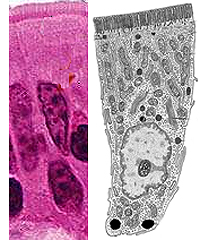|
The digestive tract continues from the stomach through the small and
large intestines or bowels. The small intestine is a long organ with
three regions along its length: the duodenum, the jejunum, and the
ileum. Except for specialized structures that are present, such as
Brunner’s mucous glands in the duodenum and Peyer’s patches in the
ileum, all three regions of the small intestine are rather similar
histologically and all are involved primarily in food digestive and
in absorbing the products of digestion.
Learning objectives:
- Understand the structural basis
of absorption in the small intestine
- Recognize the histological and
functional differences between the small and large intestines
Be able to identify
Brunner's glands and small aggregates of lymphocytes on. Classify Brunner’s glands as to staining property (serous
or mucous) and mode of secretion.
 Describe
the process by which enterocytes and goblet form, migrate, and
eventually disappear from the surface of villi. Describe
the process by which enterocytes and goblet form, migrate, and
eventually disappear from the surface of villi.
Brunner’s glands supplement what other glands?
Lacteals are an example of what structure studied earlier in the
course?
But things
don't always go as designed.
|